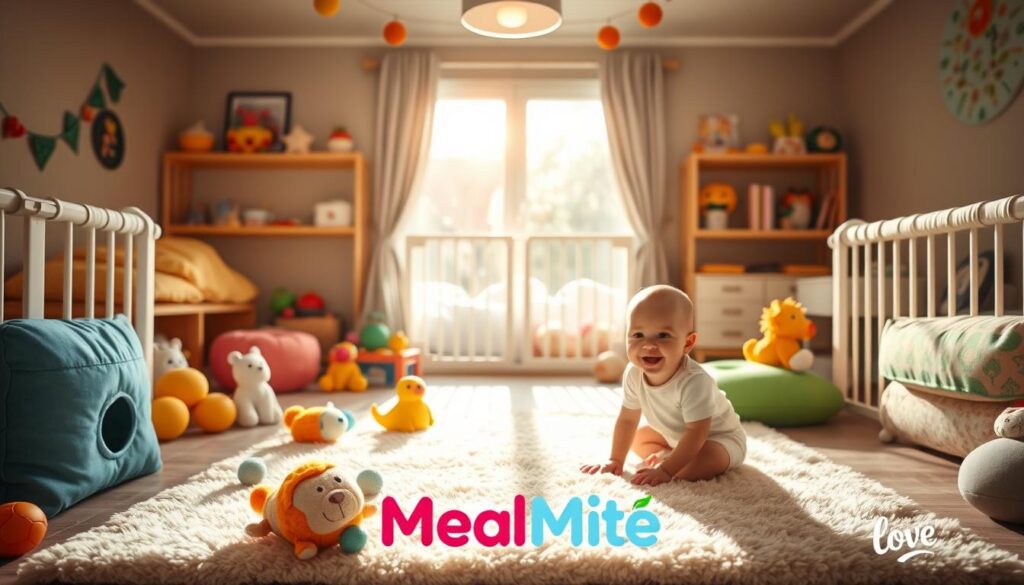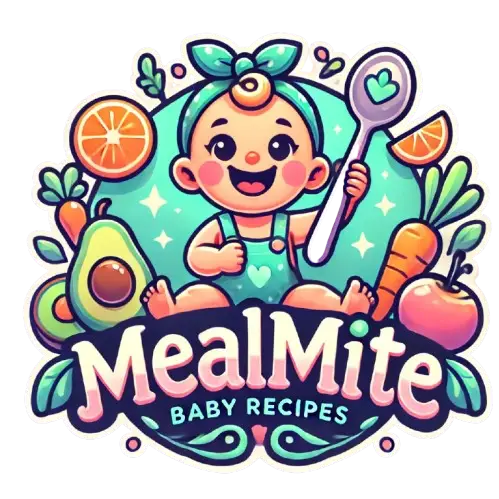Playtime is key for a baby’s growth, and giggling shows they’re happy. Babies start smiling around 2 months, showing they’re ready for fun games. Playing with them helps their brains and bodies grow, making them laugh and giggle.
Table of Contents

Games like peek-a-boo make babies laugh and bond with their parents. Toys that are bright and easy to hold make playtime more fun. These activities help babies learn and grow, making them laugh and giggle more.
Key Takeaways
- Playtime is essential for a baby’s cognitive and motor skill development
- Babies typically start smiling at 2 months and laughing at 4 months
- Interactive play, such as peek-a-boo, can elicit laughter and enhance attachment security
- The use of toys during playtime can increase a baby’s engagement levels and encourage a baby giggle
- Consistent verbal interaction can result in earlier language acquisition and a happy baby laugh
- Parents can encourage a baby laugh and an infant chuckle through various games and activities
- Engaging in play and interaction is vital for a baby’s overall development and happiness, including a baby giggle
Understanding the Magic of Baby Giggles and Their Development
Baby laughter is a universal phenomenon found in all cultures in the first four months. Research shows that infants as young as five months can tell the difference between normal and absurd situations. They laugh at the absurd ones. This skill is key to their cognitive and emotional growth, often accompanied by happy baby sounds and toddler giggles.
Studies reveal that joyful baby laughter is more than just a response to play. It’s a way for babies to invite others to join in the fun. Babies love to share in laughter, which helps them reach important milestones in their first two years. By understanding baby laughter, parents can use laughing games to help their baby grow and develop.

- Infant laughter typically occurs around 14 to 18 weeks of age (approximately 3.5 to 4.5 months)
- By eight months, infants can exhibit nonverbal humor, known as “clowning,” effectively engaging in comedic behavior without using words
- Babies can employ teasing behaviors, such as feigning disgust with a Cheerio and smiling coyly, as early as six months
By recognizing and responding to these milestones, parents can encourage their baby’s joyful baby laughter. This supports their overall development.
| Age | Milestone |
|---|---|
| 14-18 weeks | Infant laughter typically occurs |
| 5 months | Infants can distinguish between ordinary and absurd scenarios |
| 8 months | Infants can exhibit nonverbal humor |
Safety First: Guidelines for Playing with Your Little One
Playing with your baby is a joy, but safety comes first. As you play, make sure the area is safe and free from dangers. The American Academy of Pediatrics says a safe space is key for your baby’s growth.
Here are some important tips to keep in mind:
- Always watch your baby during playtime
- Choose safe toys that fit their age
- Stay away from activities that could shake or bounce your baby

By following these tips, you can make playtime safe and fun for your baby. Always put your baby’s safety first. If you have any worries, talk to your pediatrician.
Peek-a-Boo: The Classic Baby Giggle Generator
Playing peek-a-boo with your baby is a great way to help them think and learn. It’s a simple game that can make your baby laugh. By covering your face and then revealing it, you create a fun surprise.
You can play peek-a-boo in many ways, depending on your baby’s age. For example, you can use a scarf or blanket to cover your face. As your baby grows, you can make the game more exciting by hiding behind a curtain.
Different Ways to Play Peek-a-Boo
- Use a scarf or a blanket to cover your face
- Hide behind a curtain or under a blanket
- Make funny faces and sounds to add to the game
- Use a mirror to reflect your face and create a sense of surprise
Why Babies Love This Game
Babies enjoy peek-a-boo because it helps them understand that things exist even when they can’t see them. It also makes them feel safe and happy. Playing peek-a-boo helps strengthen your bond with your baby and boosts their learning and feelings.

Peek-a-boo is a timeless game that makes babies smile and helps them learn. It’s a simple yet effective way to encourage your baby’s thinking and learning. Plus, it helps you bond with your little one.
| Age | Developmental Stage | Peek-a-Boo Variation |
|---|---|---|
| 4-6 months | Object permanence | Cover your face with a scarf or blanket |
| 6-9 months | Sensory exploration | Cover your face with scarf or blanket |
| 9-12 months | Problem-solving | Use a mirror to reflect the face |
Gentle Tickle Games That Spark Joy
Gentle tickle games are a great way to make babies laugh and have fun. They work for babies of all ages, from newborns to toddlers. It’s important to watch for signs that the baby is okay and enjoying the game.
Some fun games include tracing the baby’s face with your finger or tickling their toes. You can also play “pat-a-cake” on their tummy. These games make babies happy and help them laugh, strengthening the bond between them and their caregivers.
Here are some benefits of gentle tickle games:
- Stimulate a baby’s senses and encourage laughter
- Help to create a sense of trust and bonding between the baby and caregiver
- Can be played with babies of all ages, from newborns to toddlers
It’s key to listen to the baby’s cute baby giggles and adjust the game as needed. If the baby seems uncomfortable, slow down or stop the game. This way, caregivers can make sure the baby has a good time.
| Game | Age Range | Benefits |
|---|---|---|
| Gentle Tickle Games | Newborns to Toddlers | Stimulate senses, encourage laughter, create bonding |
Making Silly Faces and Sounds for Baby’s Entertainment
Getting a baby to giggle is a joy for parents. Making silly faces and sounds is a great way to make them laugh. It also helps their brain grow. By using funny faces and sounds, parents teach their babies about different expressions and voices.
Babies start giggling around 4 months old. By 6 months, they laugh out loud. They learn to play games like peekaboo and understand sounds and faces. Making silly faces and sounds strengthens the bond between the baby and their caregiver.
Funny Facial Expressions That Work Best
Some funny faces that make babies laugh include crossing your eyes and sticking out your tongue. Try making different emotions like happy and sad. Being creative and having fun is key to making your baby laugh.
Voice Variations to Try
Changing your voice can also make a baby giggle. Use different tones and volumes to keep things interesting. Try making silly sounds like “boo” or “beep.” Mixing funny voices with faces makes for a fun experience for your baby.
Creating Your Baby Giggle Games at Home
Getting toddler giggles and happy baby sounds is key for a baby’s growth and bonding with parents. You can make your games at home to encourage laughter. Try using everyday things like a blanket for peek-a-boo or a toy for funny sounds.
Here are some ideas for your baby giggle games:
- Play with sensory toys, like texture balls or sensory mats
- Make a “sensory bin” with rice, beans, or sand and hide small toys
- Play music and get your baby to dance
These games can help your baby’s brain grow and make them laugh more. Always watch your baby during play and keep them safe.
| Game | Age Range | Benefits |
|---|---|---|
| Peek-a-boo | 6 months and up | Develops object permanence and encourages laughter |
| Sensory play | 4 months and up | Stimulates cognitive development and encourages exploration |
Movement-Based Activities That Trigger Happy Baby Sounds
Getting your baby to move can help them grow and make them giggle. Babies love bouncing and flying, which makes them laugh. These activities help them move and explore, leading to lots of laughter.
Studies show babies start giggling around 3 to 4 months. By 6 months, they giggle when tickled. Games that make them move, like bouncing and flying, help them laugh more.
Bouncing Games
“Giddy-up” is a fun game that makes babies laugh. It involves bouncing them on your knee, which they love. You can also use a big exercise ball or a baby bouncer chair for more fun.
Gentle Flying Games
Gentle-flying games are great for making babies chuckle. Try flying them gently through the air or use a soft toy to make it feel like flying. This can make them laugh a lot.
Rolling and Tumbling Fun
Rolling and tumbling games are perfect for older babies. Gently rolling them on a soft surface or using a soft tunnel can make them giggle. These games help them develop their motor skills.
| Age | Activity | Response |
|---|---|---|
| 3-4 months | Bouncing games | Cute baby giggles |
| 6 months | Gentle flying games | Adorable baby chuckles |
| 8-12 months | Rolling and tumbling games | Baby laugh |
Using Everyday Objects to Create Laughter Moments
Parents can use everyday objects to help their baby’s brain grow and make them laugh. By using things found at home, parents can make learning fun and full of laughter. For instance, making a duck quack sound or shaking a toy can make some babies giggle.
To keep the laughter going, parents need to keep trying every day. They can try different silly things to make their toddler laugh. Here are some ideas for using everyday objects to make your baby and toddler laugh:
- Using a wooden spoon to create a drumming sound
- Blowing bubbles for the baby to pop
- Creating a sensory bin filled with different textures
These activities not only make kids laugh but also help them learn and grow. By playing with everyday objects, parents can make a fun and engaging space for laughter and learning.
Experts say laughter is key to a child’s growth. Using everyday objects to make kids laugh can help with this. By being creative and having fun, parents can help their babies develop a sense of humor and encourage laughter.
| Age | Laughter Development |
|---|---|
| 4-6 months | Babies start laughing and smiling |
| 6-12 months | Babies take delight in unexpected actions |
| 12-15 months | Babies start initiating humorous actions |
Best Times of Day for Playing Giggle Games
Playing giggle games with your baby is great for their growth and bonding. Pick the right time when they’re well-rested and fed. This is when they’re most likely to laugh and giggle.
Knowing your baby’s mood and play routine is key. If they love mornings, play then. Afternoons might be better if they’re more energetic. Be flexible to match their unique rhythm.
Reading Your Baby’s Mood
It’s important to know when your baby is ready to play. If they’re tired or cranky, wait until they’re more relaxed. When they’re alert and engaged, it’s the perfect time to play.
Creating a Routine for Play
Having a playtime routine is helpful. Choose a specific time, like after breakfast or before bed. This builds excitement for play. Listen for laughter and encourage giggles to create a fun atmosphere.
Every baby is different, so be patient and flexible. By paying attention to their needs, you can strengthen your bond. This leads to more laughter and giggles from your baby.
| Time of Day | Baby’s Mood | Playtime Activities |
|---|---|---|
| Morning | Alert and engaged | Peek-a-boo, silly faces, and gentle tickle games |
| Afternoon | Relaxed and calm | Reading, singing, and gentle movement games |
| Evening | Tired and sleepy | Soft music, gentle rocking, and soothing games |
When to Step Back: Recognizing Overstimulation Signs
As parents, it’s key to spot when our babies are overstimulated. This can happen due to loud places, noisy events, or too much screen time. Babies with too much sensory input might get fussy, irritable, or even jerk their limbs. It’s important to know when our baby is feeling overwhelmed, like when they clench their fists, cover their ears, or cry a lot.
Having a consistent schedule helps babies feel secure. Also, knowing when they’re hungry, tired, or uncomfortable helps avoid meltdowns. Some signs that a baby is overstimulated include:
- Clenching fists
- Covering ears
- Rubbing eyes
- Making sudden jerking movements
- Crying uncontrollably
- Turning their head away from the source of the overstimulation
By listening to our baby’s cues, we help them feel secure. This is good for their future relationships and emotional health. A baby’s infant chuckle or toddler giggles can quickly turn to tears if they’re overstimulated. So, it’s vital to know their limits and give them breaks to keep their laughter joyful and healthy.
By understanding and responding to our baby’s cues, we create a safe space for play. This promotes healthy growth and strengthens our bond with our children.
| Signs of Overstimulation | Responsive Parenting Strategies |
|---|---|
| Clenching fists, covering ears | Provide a calm environment, reduce noise levels |
| Crying uncontrollably | Check for physical needs, offer comfort and reassurance |
| Jerking limbs, rubbing eyes | Take breaks, provide a quiet space for relaxation |
Conclusion: Building Lasting Bonds Through Laughter
Laughter is more than just fun. It’s a way to connect deeply with others, no matter their age or background. Baby giggles, infant chuckles, and toddler giggles help parents and children form strong bonds.
Research shows that happy baby sounds and joyful baby laughter are good for our health. They boost our immune system and reduce stress. Adding cute baby giggles and adorable baby chuckles to our days can strengthen our connection with our children.
Let’s cherish the laughter in our lives. Baby giggles and infant chuckles lead us to moments of joy and connection. These moments leave a lasting impact on our hearts and minds.
FAQ
When do babies typically start giggling?
Babies usually start giggling and laughing around 3-4 months. This is when they begin to understand humor and recognize familiar faces and sounds.
What are the benefits of laughing games for infant development?
Laughing games help babies think, learn, and feel joy. They also strengthen the bond between parents and their babies.
What are some safety guidelines for playing with babies?
Always watch over babies during play. Use safe toys and avoid hazards. Pay attention to their cues to prevent overstimulation.
Why do babies love the game of peek-a-boo?
Peek-a-boo helps babies understand that objects exist even when they can’t see them. It also brings joy and laughter as they see faces appear and disappear.
How can tickling games safely stimulate a baby’s senses?
Gentle tickling can make babies laugh and have fun. Just be careful not to overstimulate them.
What are some tips for making silly faces and sounds to entertain babies?
Making funny faces and sounds can help babies think and learn. Adding movements can make it even more fun for them.
How can parents create their own baby giggle games at home?
Use everyday objects to make babies laugh. This encourages creativity and bonding between parents and their babies.
What are some movement-based activities that can trigger happy baby sounds?
Activities like bouncing, flying, and tumbling can make babies move and explore. They help with physical development.
How can parents use everyday objects to create laughter moments?
Household items can help babies think and learn. They can also make babies laugh and feel joy.
What are the best times of day for playing giggle games?
Play when your baby seems happy and ready. Watch for signs of too much stimulation. This keeps playtime safe and fun.


1 thought on “10 Funny Games to Make Your Baby Giggle”